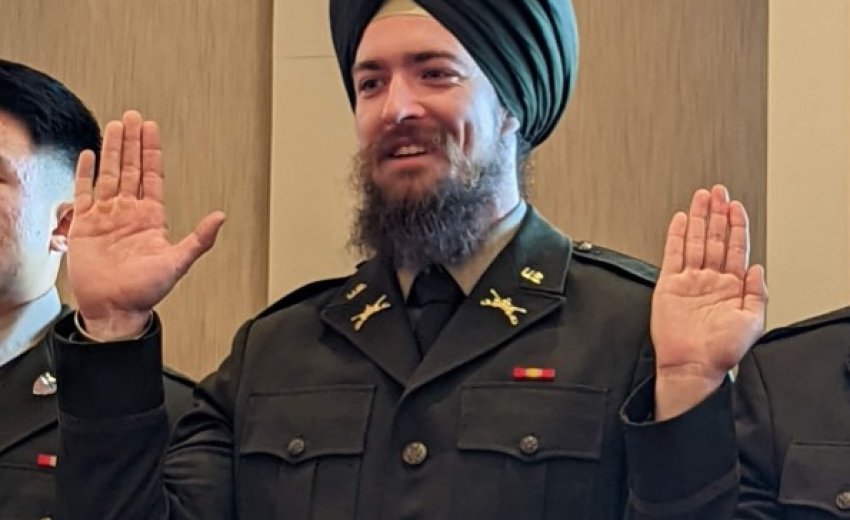In 2015, Tom Gjelter of National Public Radio, during the All things Considered segment, asked the question: Why are there only three observant Sikhs serving in the United States Army?
Although the numbers of religiously observant Sikhs serving in the US armed forces is relatively small to date, recent innovations and outreach efforts by the United States Armed Forces Chaplaincy and the greater efficiency in being given Religious Accommodations, is sure to increase the numbers.
Observant Sikh in the US Army
Guru Raj Singh is a third generation American Sikh with a long and deep connection to India. His mother first attended boarding school in Mussoorie and Guru Raj spent several years studying in Amritsar at Miri Piri Academy. His home is deeply immersed in Sikhi and he is well versed in Punjabi culture. He credits the many stories of bravery from Sikh history as an important aspect to why he feels that the Sikh faith and values align well to serving in the armed forces. He also says his years spent at Miri Piri Academy, trained him in various life skills such being on time, appreciating the uniform and being able to fit into a highly structured lifestyle. On his father’s side he comes from a long line of persons serving in the US military. Several of his uncles and both his grandmother and his grandfather, going back to his great grandfather have served in the US armed forces. It was Guru Raj’s father who inspired him to sign up for the army. From the beginning it was clear that he would have to apply for a Religious Accommodation, to be able to serve while keeping both his hair, beard and wearing a turban. Since uniform regulations changed in the mid-eighties from previously allowing Sikhs to maintain religiously mandated beards and turbans while in uniform, it has become more difficult for observant Sikhs to be allowed to serve while adhering to tenant’s of the Sikh faith. Several lawsuits and active lobbying on behalf of the Sikh Coalition and others, has paved the way for more inclusivity and acceptance of faith garb while in uniform. Notably under the Religious Freedom Restoration Act (1993) which lead to Muslims being allowed to wear Burkhas and Hijabs and Sikhs wearing turbans and beards while in the armed forces.
Sikhs were known to be such a strong and memorable part of the Imperial British Army and made remarkable contributions in both the first and second world war, have been lesser known in a historical sense in the US armed forces, which is perhaps a reason why the road to the Religious accommodation for Sikhs has been long. Nowadays the process takes about 9 months and has a few key components to it. First the applicant is asked to write a letter explaining why a Religious exemption should be granted to them. Secondly a letter certifying the sincerity and the fact that the person is an integral part of a practicing community, is attested to by the religious organization headquarters, or Gurdwara Committee and signed by a minister. This is sent to the army which then proceeds to appoint a chaplain to conduct interviews with the applicant. Most branches of the United States Armed Forces have their own Chaplaincy. The first chaplain was appointed as early on as in 1791. Until 1862 only Christians could serve as chaplains, this changed in 1862 when the first Rabbi was appointed as a chaplain by President Lincoln. The navy recently commissioned both a male and a female Muslim chaplain. Although there are no Sikh chaplains yet, it is to be noted that the office of the Chaplain of the Pentagon, has hosted several Vaisakhi celebrations with Kirtan presentations. The British Armed Forces appointed their first Sikh Chaplain in 2005, when commissioning Mandeep Kaur to the post.
Guru Raj Singh mentions that he had several interviews with the chaplain, which he found to give depth to the questions around his religious practices and what that would look like in an active duty setting. Guru Raj expresses what this means to him:
“For me being allowed to keep my beard and turban in the army allows me to follow my religion the way I would like to practice it. I take pride in being able to show other Sikhs that we can serve our country while still practicing our religion and keeping our articles of faith.”
I chose to branch armor because I wanted to be in a big, loud and powerful machine close to the action. I was also inspired by my uncle William Taylor who told me stories from his career as an armor officer as I was growing up and I want to have stories of my own someday.
Article is provided by Miri Piri Academy
Miri Piri Academy is an international school in Amritsar, India for both residential and day school students in grades 5-12. We focus on meditation and self-reflection, hard work and sharing with others. We have modelled our program on the teachings of Kundalini Yoga as taught by Yogi Bhajan, Sikh philosophy and lifestyle and an experiential learning model using the Cambridge curriculum.
